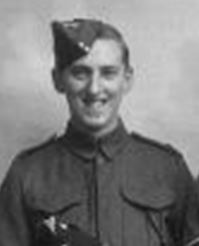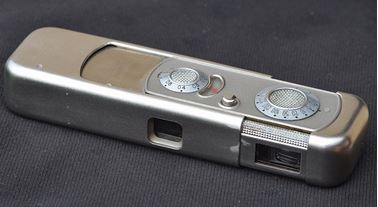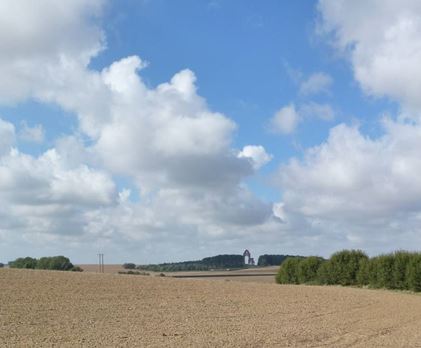Henry George 'John' Hutchins was born in Norfolk Square, London, the eldest son in a family of three boys and two girls. Not long after his birth, his parents moved to Swindon, Wiltshire, in search of work.
John spent his childhood and early adolescence in Swindon, which was then still a small market town, with the Great Western Railway works dominating the new part of the town. He was happiest helping out on the neighbouring farm, where he learned a great many of the country skills which would later be of considerable use to him during his Auxiliary Units service.
His father had volunteered for the 1914-18 war, seeing action in the first few months where he and his comrades earned themselves the famous 'Old Contemptibles' label, and then later on the Somme where he was almost fatally wounded in the throat. Invalided out of the war in 1917, he was keen to see his son avoid the threat of trench warfare, and encouraged John to join the RAF. For administrative reasons the enrolment didn't happen, and John joined the 4th Wiltshire Regiment in January 1941. He was sent on an Officers Training Course at Cheltenham, where he was offered and turned down a sniper's course and a commission in the Guards. At that time the Guards were becoming armoured and John preferred to take his chances outside rather than inside a tank.
Returning to barracks he noticed a small card on the board calling for 'volunteers for special duties', and signing up soon found himself treading the now well-chronicled path to Highworth Post Office thence to Coleshill House. Lord Glanusk by this time was running Coleshill, and the atmosphere was one of comradeship and much 'derring-do'. All the men, like soldiers everywhere, had to learn to reverse the instinctive recoil from doing harm to another human-being to one of automatic aggressive action. So successful were the Coleshill methods that, one night on leave at home, blackout being in place, he found himself in reflex combat with a brick wall into which he'd walked!
Training completed and issued with all sorts of exciting special equipment such as a Minox subminiature camera and tripod, revolver and non-reflective dagger, he took the train to Bridport and then onto Duntish Court where he met up with friends such as Ron Handford, John Miles and Jack Blandford. Soon he was again picked as a sniper and given a small brown envelope, inside which, he was told, he would find a name. In the event of an invasion, and only in the event of an invasion, he was to open the envelope, read the name, find whoever it may be, and shoot him (or her, presumably), as this would be someone already marked down as a Nazi sympathiser.
He took part in numerous training operations around the Bridport area, including the 'attack' described by Denis Blandford (on Lord Lovat's commandos, of which he and Jack were particularly proud. In this operation he had to photograph all the documents which an enemy would have snapped, and mark them all with a cross, so he was able to use the Minox and to see it in action. He was very impressed by this little machine and always regretted dutifully handing it in with all his other kit (including the unopened brown envelope of course) when Auxiliary Units were stood down and he returned to 43rd Wessex in 1943/4!
Soon after returning, he was sent back again to Hampshire, this time to work with Combined Operations on Hayling Island. From here he was dispatched with sand-sampling equipment towards the Normandy beaches ear-marked for the invasion. From the Royal Navy vessel he rowed ashore in a canoe and took some samples by driving tube-shaped devices into pre-arranged spots in the shoreline. Returning to the canoe he was hit in the lower jaw by a ricochet - fortunately it was close enough only to bloody his face and loosen his teeth, and he returned safely to Weymouth not long after dawn.
He applied with his Unit for SAS training, but before he could set out was involved in a serious car accident in which he sustained a head-injury. This kept him in hospital for too long to take part in the planned pre-invasion activities, and instead he crossed to France in June 1944, now attached to 4th Wiltshire Regiment. He saw action at the Battle for Caen with 43rd Wessex now part of XXX Corps under General Horrocks, at the notorious Hill 112 (part of Operation Jupiter), Mont Pincon (Operation Bluecoat), the Falaise Gap, and at Vernon, crossing the Seine as part of Operation Neptune. Northern France had now fallen and they headed relatively briskly towards the Escaut Canal on the Belgian Border. This journey took him and his comrades across the old Battlefields of The Somme where his father and many of theirs had fought not twenty years previously; they were able to see in the distance the sad brooding silhouette of the Thiepval Memorial, the paradox of which must surely have evoked some poignant questions. There was more action than on the Belgian border, after which the next stop was Nijmegen for Operation Market Garden. Travelling towards Arnhem he was now in charge of a Scout Car and supposed to be in full Reconnaissance mode, but the famous traffic jams in the corridor meant that he and the rest of the 43rd Wessex were virtually paralysed, bogged down by the narrow road and sodden terrain. Finally they moved on, to some of the worst fighting of the war, at Nijmegen and Eindhoven.
Exhausted, they were taken out of the line and billeted in a barn where, settling down for a well-earned rest, they were suddenly called to the Ardennes. Weakened by cold - they'd been sleeping in slit-trenches cut in the snow - but doubtless fortified by a Christmas dinner of meat, vegetables, gravy, Christmas pudding and custard all served up on the same plate, on 27 December XXX Corps managed to push the 2nd Panzers out of Celles. From here John moved on with the Division and took part in more heavy fighting before crossing the Rhine at Xanthen.
After the crossing, there was a good deal more opportunity for scouting and on one of these missions John was able to photograph a strange-looking aircraft which, years later he discovered to be the first rocket-fuelled jet fighter plane.
Members of the 43rd Wessex Reconnaissance Corps were among the first to enter Belsen Camp. Even the horrors of battle had not prepared John or anyone else for what they found there. He said afterwards that no matter how many reports one read, nor how many films and programmes one saw on the Camp, nothing came close to the shock of entering the place for the first time and, of course, no amount of reporting could reproduce the terrible, terrible smell. He was among a team writing reports on cannibalism, and photographing the site for official records. His papers were later passed to the Imperial War Museum. He remained throughout the clear-up operation, living in the former SS barracks, and taking part in the mass burials, fumigation, organisation of surviving camp inmates, and the organisation of the forced viewings implemented on the local populace; eventually he witnessed the final firing of the Camp buildings.
John was at Bremen on 8th May and Peace was announced. From there he was moved to Hannover and from there to Bad Oeyenhausen with the Allied Control Commission, in charge of Transport. He was demobbed at the end of 1946 and returned to the UK.
Like almost all those who fought in and survived the war, he remained haunted by what he had seen but said comparatively little about it. Particularly, of course, he said next to nothing about Auxiliary Units. In the late 1990s he was closely involved with the Coleshill Memorial Trees project, and in 2000 passed most of his papers and photographs to the Imperial War Museum as part of their millennium celebrations.
John stayed remarkably fit and active right up until his final illness. He died not long before his 90th birthday. He is very sadly missed.
| Unit or location | Role | Posted from | until |
|---|---|---|---|
| West Dorset Scout Section | Scout Section Member | 1941 | 1944 |
Driver's mate on a Petrol Lorry (1939)
Mandy Hutchins
https://www.iwm.org.uk/collections/item/object/1030034927
1939 Register
Ancestry.co.uk


